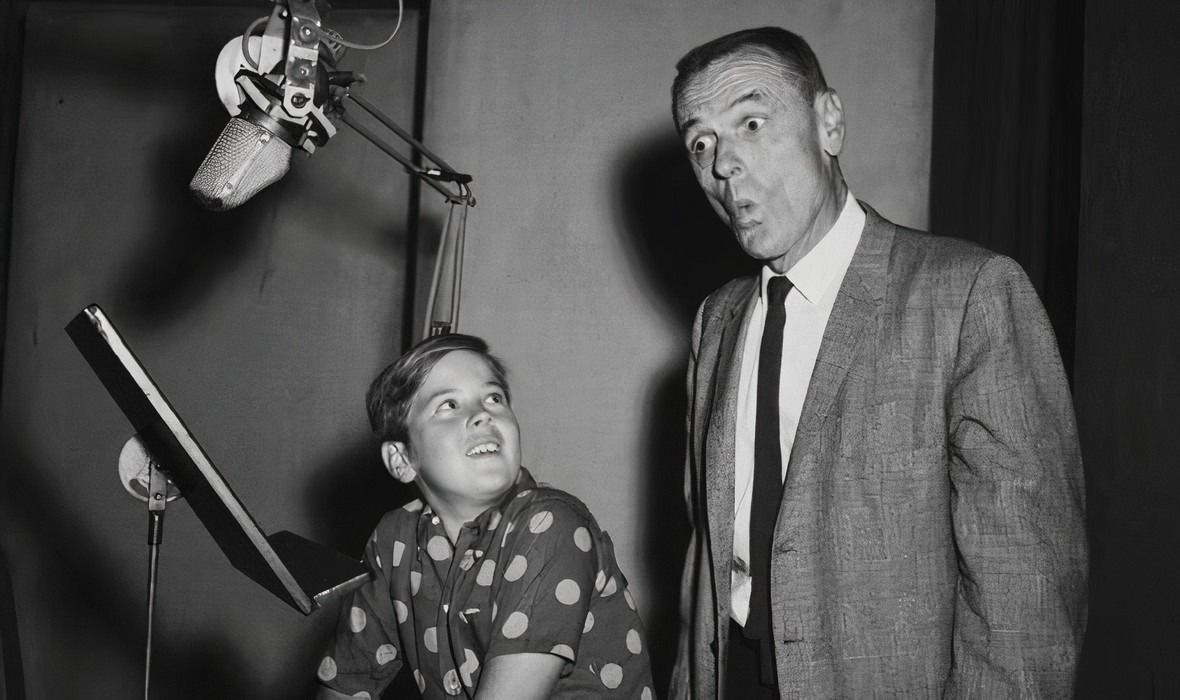
Child Voice-Acting: Disney’s Secrets You Should Know If You Work in Media
In this article, we will provide you with how-to-cast tips, case study analysis, as well as important points to consider while casting for child voice-overs.
To illustrate this, we’ ll be using the examples of one of the most creative and respected brands out there: Disney. A pro among the pros when it comes to conveying emotion.
The Disney Approach
Can you imagine AI voices in a Disney movie? Of course not!
Being “king” of media and entertainment, Disney knows like no other how to cast and work with branded voice-overs. As a result, every single character possesses original personality traits, a good side, a bad side, a paradox, and of course… a unique voice!
Photo credit: pexels.com

Casting for the Perfect Child Voice-over?
Disney’s approach
When it comes to children, Disney uses a unique approach. The producers divide the script into small parts – or even sentences – and “feed” them to children. By using visuals, mood boards, or even puppets, they play different versions of the same “script part”
But there’s something else. The creative department spends some time with the young voice talent to experiment on the fictional character as well, so we can say there’s an interaction, that the talent influences the hero and vice versa. And the key to their success lies in this interaction.

Finding Nemo
Nemo – Alexander Gould
Photo credit: disney.fandom.com
A playful voice
For Nemo, Disney looked for a child actor that would fit this well-developed character. Nemo’s major characteristics were:
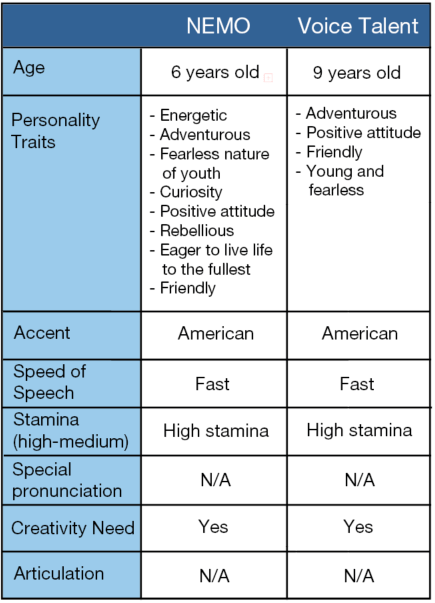
However, his character goes through a major change, in the end, he shows maturity and leadership qualities.
Alexander Gould was selected for the role. A talent with a playful voice that manifests the adventurous nature of Nemo. Moreover, Alexander and Nemo share common character qualities:
“I’ve always been an adventurous person, so that was a big similarity between the character and myself (…) Wanting to break away and be your own person. I think that’s one of the reasons it has done so well and one of the reasons I was able to connect to it.”

Monsters Inc
Boo – Mary Gibbs
Photo credit: Monsters, Inc. – Behind the Screams Special
Gibberish vocabulary
Boo’s role in the movie is to “humanize” monsters. She is a very friendly, tiny, cute-little-thing. Boo – just like the voice talent – is a 3-year-old that can speak, however, like a baby, with gibberish vocabulary. In the film, the only actual words she says are: “Boo!”, “Kitty!”, “Ew” and “Mike Wazowski!”.
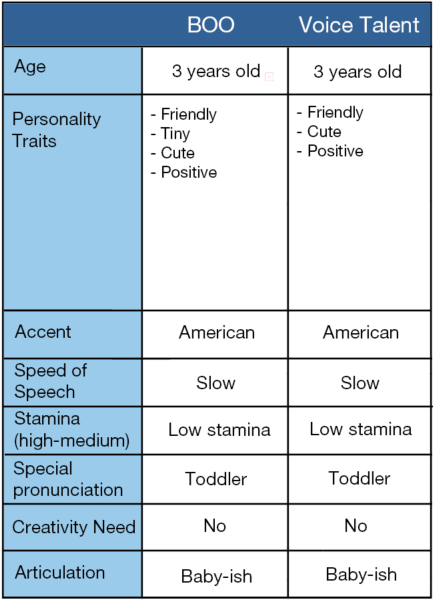
Mary Gibbs was the voice talent Disney selected for this character. Having a dad that worked as a story artist in Disney, she felt comfortable right from the beginning even though she was very young. The producers “fed” her the script little by little, working together with a puppet to help her understand the emotions each word should carry.
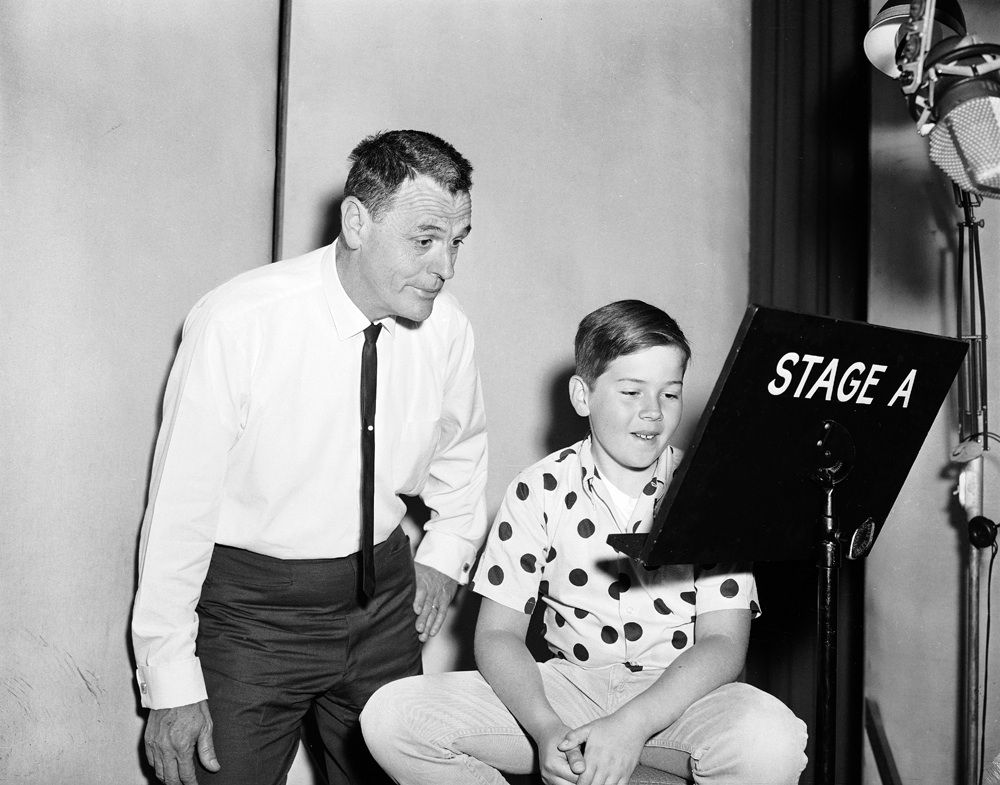
The Jungle Book
Mowgli – Bruce Reitherman
Photo credit: andreasdeja.blogspot.com
A child of a happy-go-lucky nature
The Jungle Book is a landmark movie for Walt Disney Productions, as it was the last movie of Walt Disney. Walt Disney died months before its premiere. Disney’s Mowgli is slightly different in character than Kipling’s. This is because Walt Disney wanted to have a different, more “fun” version of the famous story.
Mowgli is portrayed as an average child in the original film having an innocent, mischievous and happy-go-lucky nature. However, he’s also rebellious and insecure, and incredibly brave despite his lack of animal survival instincts. The hardships he had to face in the jungle increased his feelings of insecurity and rebelliousness. Mowgli fails to understand the circumstances of his situation and that results in feeling unwanted and unworthy of love. Nevertheless, Mowgli matures in the end and would come to understand and accept his future in the “man village”.
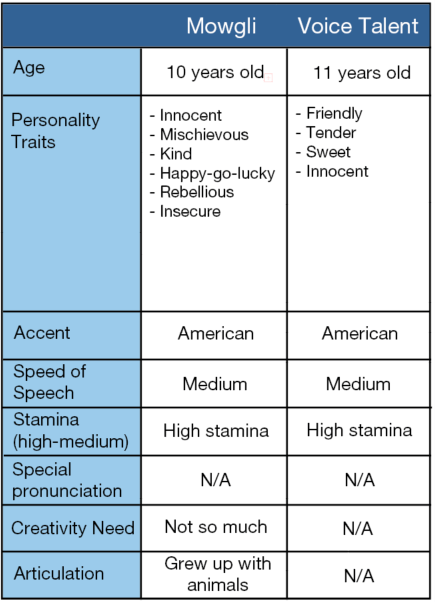
Bruce Reitherman, the son of animator Wolfgang Reitherman, having already voice acting experience as Christopher Robin in “Winnie the Pooh and the Honey Tree”, was selected to voice this complex character. At the age of 11 and with a tender, sweet and innocent voice, he had already two successful voice overs in his resume.
Working with Children
When working with children, your creativity should match your patience!
Sometimes the right voice might be far from what your first thought of! One example of this is the work done together with Drenday for their Bestseller sustainability campaign. Drenday x Bestseller campaign.
Drenday approached VoiceArchive with a desire to cast a girl’s voice for this specific Bestseller campaign. However, the right voice to convey the message of this project, the one with the right pitch, tone, and pace, and the one that ultimately matched their expectations for the character, turned out to be one of our boy talents!
Tips and Advice
Directing a child differs when it comes to explaining instructions or a project’s concept. Other things we consider when working with children is that they might:
- Be easily distracted
- Have lower stamina
- Be sensitive to criticism
There might also be more chances for misunderstandings!
Does that mean you should hire an adult to do the child’s voice?
Absolutely not!
No adult can beat the pure, innocent, honest, authentic voice of a child.
You just work differently. That is why we do not have children visible in our pool. That is why we do not offer live sessions with them.
During a recording with children, we do things with a twist. These sessions need patience and persistence. So, you should select the right people for this stage. We highly advice you to use alternative ways and material (like mood boards and visuals) to explain script, emotions, and ideas. Also, consider breaking down the script into small parts – even sentences sometimes – to work little by little with lots of patience and creativity.
To make sure children feel comfortable and familiar we advise you to always have one or both parents present. That is how we work at VoiceArchive.
Need free advice and tailor-made advice?
Contact now our voice-over professionals and get tailor-made advice.
In need of further assistance?
We beat your deadline. The first time, every time!

Anna Sticken
Global Key Account Manager


